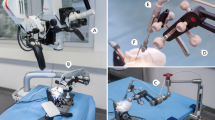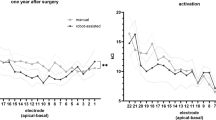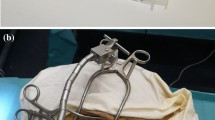Abstract
Purpose
During traditional insertion of cochlear implant (CI) electrode arrays (EAs), surgeons rely on limited tactile feedback and visualization of the EA entering the cochlea to control the insertion. One insertion approach for precurved EAs involves slightly overinserting the EA and then retracting it slightly to achieve closer hugging of the modiolus. In this work, we investigate whether electrical impedance sensing could be a valuable real-time feedback tool to advise this pullback technique.
Methods
Using a to-scale 3D-printed scala tympani model, a robotic insertion tool, and a custom impedance sensing system, we performed experiments to assess the bipolar insertion impedance profiles for a cochlear CI532/632 precurved EA. Four pairs of contacts from the 22 electrode contacts were chosen based on preliminary testing and monitored in real time to halt the robotic insertion once the closest modiolar position had been achieved but prior to when the angular insertion depth (AID) would be reduced.
Results
In this setting, the open-loop robotic insertion impedance profiles were very consistent between trials. The exit of each contact from the external stylet of this EA was clearly discernible on the impedance profile. In closed-loop experiments using the pullback technique, the average distance from the electrode contacts to the modiolus was reduced without greatly affecting the AID by using impedance feedback in real time to determine when to stop EA retraction.
Conclusion
Impedance sensing, and specifically the access resistance component of impedance, could be a valuable real-time feedback tool in the operating room during CI EA insertion. Future work should more thoroughly analyze the effects of more realistic operating room conditions and inter-patient variability on this technique.







Similar content being viewed by others
References
What are cochlear implants for hearing? | NIDCD. https://www.nidcd.nih.gov/health/cochlear-implants. Accessed 21 July 2020
Carlson ML, Driscoll CLWW, Gifford RH, Service GJ, Tombers NM, Hughes-Borst BJ, Neff BA, Beatty CW (2011) Implications of minimizing trauma during conventional cochlear implantation. Otol Neurotol 32(6):962–968. https://doi.org/10.1097/MAO.0b013e3182204526
Chakravorti S, Noble JH, Gifford RH, Dawant BM, O’Connell BP, Wang J, Labadie RF (2019) Further evidence of the relationship between cochlear implant electrode positioning and hearing outcomes. Otol Neurotol 40(5):617–624. https://doi.org/10.1097/MAO.0000000000002204
Vanpoucke FJ, Boermans PPB, Frijns JH (2012) Assessing the placement of a cochlear electrode array by multidimensional scaling. IEEE Trans Biomed Eng 59(2):307–310. https://doi.org/10.1109/TBME.2011.2173198
Kratchman, L. B., Schuster, D., Dietrich, M. S., & Labadie, R. F. (2016). Force perception thresholds in cochlear implantation surgery. Audiol Neurotol 21(4):244–249
Labadie RF, Noble JH (2018) Preliminary results with image-guided cochlear implant insertion techniques. Otol Neurotol 39(7):922–928. https://doi.org/10.1097/MAO.0000000000001850
Labadie RF, Schefano AD, Holder JT, Dwyer RT, Rivas A, O’malley MR, Noble JH, Dawant BM (2020) Use of intraoperative CT scanning for quality control assessment of cochlear implant electrode array placement. Acta Otolaryngol 140(3):206–211. https://doi.org/10.1080/00016489.2019.1698768
Sweeney AD, Carlson ML, Rivas A, Bennett ML, Haynes DS, Wanna GB (2014) The limitations of computed tomography in adult cochlear implant evaluation. Am J Otolaryngol 35(3):396–399. https://doi.org/10.1016/j.amjoto.2014.03.002
Perazzini C, Puechmaille M, Saroul N, Plainfossé O, Montrieul L, Bécaud J, Gilain L, Chabrot P, Boyer L, Mom T (2020) Fluoroscopy guided electrode-array insertion for cochlear implantation with straight electrode-arrays: a valuable tool in most cases. Eur Arch Otorhinolaryngol 1:3. https://doi.org/10.1007/s00405-020-06151-z
de Rijk SR, Tam YC, Carlyon RP, Bance ML (2020) Detection of extracochlear electrodes in cochlear implants with electric field imaging/transimpedance measurements. Ear Hear 41:1196–1207. https://doi.org/10.1097/aud.0000000000000837
Wang J, Wise KD (2009) A thin-film cochlear electrode array with integrated position sensing. J Microelectromech Syst 18(2):385–395. https://doi.org/10.1109/JMEMS.2008.2011722
Watanabe H, Velmurugan J, Mirkin MV, Svirsky MA, Lalwani AK, Llinas RR (2014) Scanning electrochemical microscopy as a novel proximity sensor for atraumatic cochlear implant insertion. IEEE Trans Biomed Eng 61(6):1822–1832. https://doi.org/10.1109/TBME.2014.2308058
Scheunemann CWD, Taeger J, Brecht SV, Neun T, Hagen R, Lueth TC, Rak KJ (2022) Concept and first Implementation of an intracochlearly navigated Electrode Array for Cochlear Implantation. In: 2022 44th annual international conference of the IEEE engineering in medicine & biology society (EMBC), pp 2560–2564. https://doi.org/10.1109/EMBC48229.2022.9871850.
Vanpoucke FJ, Zarowski AJ, Peeters SA (2004) Identification of the impedance model of an implanted cochlear prosthesis from intracochlear potential measurements. IEEE Trans Biomed Eng 51(12):2174–2183. https://doi.org/10.1109/TBME.2004.836518
Tykocinski M, Cohen LT, Cowan RS (2005) Measurement and analysis of access resistance and polarization impedance in cochlear implant recipients. Otol Neurotol 26(5):948–956. https://doi.org/10.1097/01.mao.0000185056.99888.f3
Giardina CK, Krause ES, Koka K, Fitzpatrick DC (2018) Impedance measures during in vitro cochlear implantation predict array positioning. IEEE Trans Biomed Eng 65(2):327–335. https://doi.org/10.1109/TBME.2017.2764881
di Lella FA, de Marco D, Fernández F, Parreño M, Boccio CM (2019) In Vivo real-time remote cochlear implant capacitive impedance measurements. Otol Neurotol 40:S18–S22. https://doi.org/10.1097/MAO.0000000000002214
Mesnildrey Q, Macherey O, Herzog P, Venail F (2019) Impedance measures for a better understanding of the electrical stimulation of the inner ear. J Neural Eng 16(1):016023. https://doi.org/10.1088/1741-2552/aaecff
Hou L (2019) The feasibility of a novel sensing system for robotic cochlear electrode array feed for hearing preservation. Brunel University London
Hafeez N, Du X, Boulgouris N, Begg P, Irving R, Coulsan C, Tourrels G (2019) Towards unblinding the surgeons: complex electrical impedance for electrode array insertion guidance in cochlear implantation. In: Proceedings of the international symposium on auditory and audiological research, vol 7, pp 39–46. https://proceedings.isaar.eu/index.php/isaarproc/article/view/2017-06. Accessed 25 May 2020
Aebischer P, Meyer S, Caversaccio M, Wimmer W (2020) Intraoperative impedance-based estimation of cochlear implant electrode array insertion depth. IEEE Trans Biomed Eng 68:545–555. https://doi.org/10.1109/tbme.2020.3006934
Watanabe H (2012) Unconventional neural interface intravascular neural interface and electrochemical endoscopy for cochlear implant. New York University
Tan C-T, Svirsky M, Anwar A, Kumar S, Caessens B, Carter P, Treaba C, Roland JT (2013) Real-time measurement of electrode impedance during intracochlear electrode insertion. Laryngoscope 123(4):1028–1032. https://doi.org/10.1002/lary.23714
Pile J, Sweeney AD, Kumar S, Simaan N, Wanna GB (2017) Detection of modiolar proximity through bipolar impedance measurements. Laryngoscope 127(6):1413–1419. https://doi.org/10.1002/lary.26183
Bruns TL, Riojas KE, Labadie RF, Webster RJ (2022) Real-time localization of cochlear-implant electrode arrays using bipolar impedance sensing. IEEE Trans Biomed Eng 69(2):718–724. https://doi.org/10.1109/TBME.2021.3104104
Salkim E (2020) Electrode array position guiding in cochlea based on impedance variation: computational study. Muş Alparslan Üniversitesi Mühendislik Mimarlık Fakültesi Dergisi 1(1):64–71
Dong Y, Briaire J, Siebrecht M, Stronks H, Frijns J (2021) Detection of translocation of cochlear implant electrode arrays by intracochlear impedance measurements. Ear Hear 42:1397–1404
Klabbers ÃTM, Huinck ÃWJ, Mylanus ÃEAM (2021) Comparison between transimpedance matrix (TIM) measurement and x-ray fluoroscopy for intraoperative electrode array tip fold-over detection. Otol Neurotol 8:1–7. https://doi.org/10.1097/MAO.0000000000003290
Lee S-Y, Kim YS, Jo HD, Kim Y, Carandang M, Huh G, Choi BY (2021) Effects of in vivo repositioning of slim modiolar electrodes on electrical thresholds and speech perception. Sci Rep 11(1):15135. https://doi.org/10.1038/s41598-021-94668-6
Pile J, Wanna GB, Simaan N (2014) Force-based flexible path plans for robotic electrode insertion. IEEE Int Conf Robot Autom 2014:297–303. https://doi.org/10.1109/ICRA.2014.6906625
Pile J (2015) Wire-actuated parallel robots for cochlear implantation with in-vivo sensory feedback. PhD Dissertation. Vanderbilt University
Hafeez N, Du X, Boulgouris N, Begg P, Irving R, Coulson C, Tourrel G (2022) Real-time data-driven approach for prediction and correction of electrode array trajectory in cochlear implantation. Appl Sci 12(13):6343. https://doi.org/10.3390/app12136343
Bruns TL, Riojas KE, Ropella DS, Cavilla MS, Petruska AJ, Freeman MH, Labadie RF, Abbott JJ, Webster RJ (2020) Magnetically steered robotic insertion of cochlear-implant electrode arrays: system integration and first-in-cadaver results. IEEE Robot Autom Lett 5(2):2240–2247. https://doi.org/10.1109/LRA.2020.2970978
Leon L, Cavilla MS, Doran MB, Warren FM, Abbott JJ (2014) Scala-tympani phantom with cochleostomy and round-window openings for cochlear-implant insertion experiments. J Med Devices Trans ASME 8(4):041010. https://doi.org/10.1115/1.4027617
Hibbert DB, Weitzner K, Carter P (2001) Voltammetry of platinum in artificial perilymph solution. J Electrochem Soc 148(1):E1. https://doi.org/10.1149/1.1344543
Riojas KE (2021) Making cochlear-implant electrode array insertion less invasive, safer, and more effective through design, magnetic steering, and impedance sensing. Vanderbilt University
Acknowledgements
The authors thank Peter Gibson of Cochlear Ltd. for providing the EAs used in these experiments.
Funding
This work was supported in part by the National Science Foundation Graduate Research Fellowship under DGE-1445197/1937963.
Author information
Authors and Affiliations
Corresponding author
Ethics declarations
Conflict of interest
R.F.L. is a consultant for Advanced Bionics and Medtronic. No other conflicts of interest.
Additional information
Publisher's Note
Springer Nature remains neutral with regard to jurisdictional claims in published maps and institutional affiliations.
Supplementary Information
Below is the link to the electronic supplementary material.
Supplementary file 1 (MP4 17115 kb)
Rights and permissions
Springer Nature or its licensor (e.g. a society or other partner) holds exclusive rights to this article under a publishing agreement with the author(s) or other rightsholder(s); author self-archiving of the accepted manuscript version of this article is solely governed by the terms of such publishing agreement and applicable law.
About this article
Cite this article
Riojas, K.E., Bruns, T.L., Granna, J. et al. Robotic pullback technique of a precurved cochlear-implant electrode array using real-time impedance sensing feedback. Int J CARS 18, 413–421 (2023). https://doi.org/10.1007/s11548-022-02772-3
Received:
Accepted:
Published:
Issue Date:
DOI: https://doi.org/10.1007/s11548-022-02772-3




